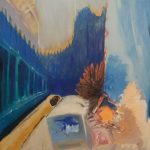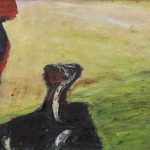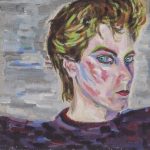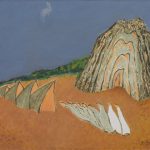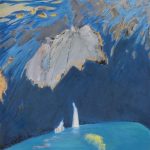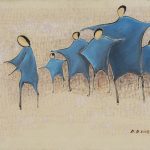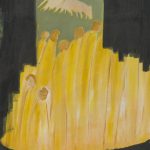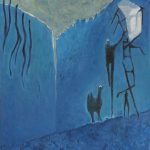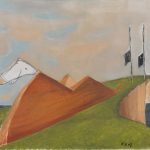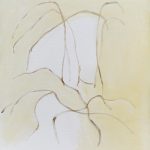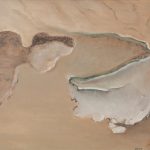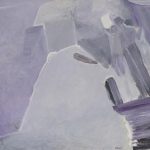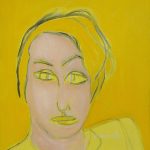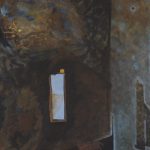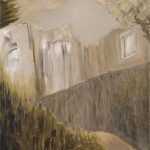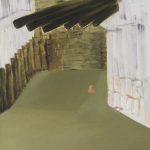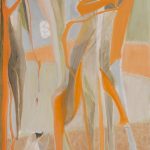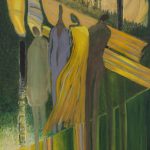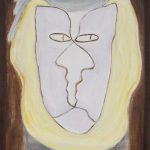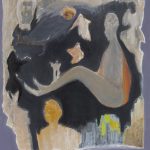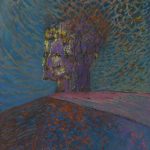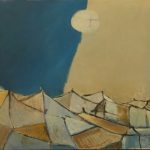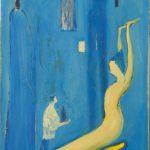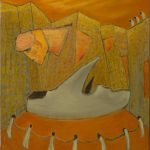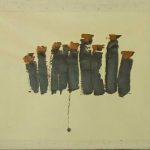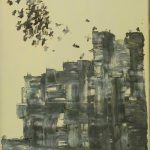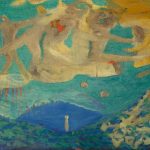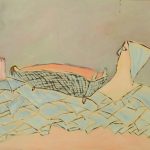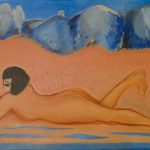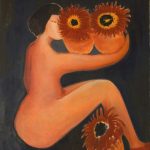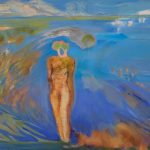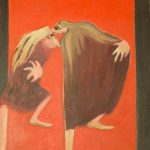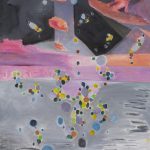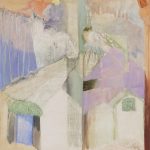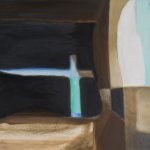AN INTERNATIONAL POETRY JOURNAL IN ENGLISH & CHINESE
Untitled
Oil & Acrylic Painting © Duo Duo

Duo Duo (Li Shizheng) was born in Beijing in 1951. As a young intellectual during the Cultural Revolution, he was “sent down” in 1969 to countryside labor in Baiyangdian, Hebei Province. An early “Misty” poet, he began writing in 1972, and publishing in 1982. After leaving China in 1989, he lived nearly 15 years in Holland. His published volumes include the poetry collections Salute: 38 Poems; Mileage: Poems 1973-1988; Amsterdam’s River; Selected Poetry of Duo Duo; Promise; Still, and the short story collection A Lift. His work has been translated into English, German, Italian, and Dutch. Snow Plain, a sequence of short stories rendered in English by John Crespi and others, appeared in 2010. Duo Duo’s honors include numerous literary prizes in China and internationally. He is the first Chinese recipient of the Neustadt International Prize for Literature in 2010. He currently teaches at the Humanities and Communication College of Hainan University, China. The Pangolin House 2014 Summer/Fall issue featured a selection of his poems.
Duo Duo began painting in the 1980s, a passion he has nourished more than three decades since, both in China and abroad. In September 2016, Beijing’s Authors’ Gallery mounted Duo Duo’s first solo exhibition, presenting work he created mostly over the current decade. Unwilling to burden his visual art with textual connotation, he leaves all his paintings untitled. The paintings presented here are drawn from that exhibition.
多多,本名栗世征,1951年生於北京,1969年到白洋澱插隊,1972年開始寫詩,1982年開始發表作品,1989年出國,旅居荷蘭數年。著有詩集《行禮:詩38首》、《里程:多多詩選 1973—1988》、《阿姆斯特丹的河流》、《多多詩選》、《諾言》、《依舊是》等多部,以及小說集《搭車》。詩歌作品被譯成英語、德語、意大利語、荷蘭語等多個語種,英文小說集《雪原》(Snow Plain)由漢學家江克平等人翻譯,2010年在美國出版。曾獲國內外多項詩歌殊榮,2010年獲紐斯塔特國際文學獎,是中國作家首次獲得此獎。現為海南大學人文傳播學院教授。《穿山甲》2014夏秋季刊譯介有多多的詩。
多多在八十年代接觸繪畫,三十餘年創作熱情不滅,陸續有繪畫作品問世。2016年9月在北京作者畫廊舉辦首次個人畫展,展出作品多為近十間的油畫,全部命名為「無題」,因作者不愿繪畫負擔多餘的文字闡釋。本期《穿山甲》呈現的畫作也出自其中。
Note
Many readers are familiar with China’s long history of poets as painters. Perhaps the most famous examples are the Tang poet Wang Wei and the Song poet Su Shi (Su Dong Po), who wrote: “In Wang Wei’s poems, there are paintings. In his paintings, poems.” Paintings from Tang and later eras often carried poems or poetic comments written within their margins, composed by the painter, another poet or artist, a scholar, or even the owner. Poetry, painting, and calligraphy have long been revered in China as “The Three Perfections”.
While this correspondence may be less frequent in the west, one thinks of William Blake, and more recently the American poets Donald Justice, Derek Walcott, and Mark Strand, each of whom created visual art. Strand began his artistic life as a painter, studying with Josef Albers for his Yale BFA. In 1994 he published Hopper, a volume of his commentary on the 20th c. painter Edward Hopper’s work. The Roman poet Horace famously declared “ut pictura poesis”, literally “as is painting, so is poetry.” Certainly in both eastern and western poetries, the relation between these forms has been profound, replete with “ekphrastic” poems composed in response to visual art. In this respect, however, eastern artists may have an advantage in the relative fluidity of both their language and aesthetic thought.
In previous issues, as well as calligraphy by Henry Lo, Pangolin House has featured painting by Chinese contemporary poets Che Qianzi and Yang Jian. Yang Jian’s poetry also appears in the current issue. We are pleased to offer a selection of Duo Duo’s paintings here, surely part of the continuing Chinese painter/poet tradition. As Duo Duo lived many years in Europe, however, and is one of the most cosmopolitan contemporary Chinese poets, viewers may find his paintings also reflect an international sensibility.
大多數讀者對中國詩人作為畫家的傳統應該不會陌生,這當中最著名的恐怕要屬唐代詩人王維和宋代詩人蘇軾。蘇軾曾評價王維「味摩詰之詩,詩中有畫;觀摩詰之畫,畫中有詩。」自唐代以降,我們往往能在畫的空白處看到由畫家本人、其他人乃至收藏者題寫的詩句或詩性文字。「詩書畫三絕」的說法在中國也由來已久。
在西方,詩與畫的關聯相對來說沒有那麼緊密。提到詩人作畫,人們常常想到英國大詩人威廉·布萊克,或者時代與我們更為接近的美國詩人唐納德·賈斯迪斯、德里克·沃爾科特、馬克·斯特蘭德等,他們都創作視覺藝術。斯特蘭德的藝術生涯起始於繪畫,他在耶魯大學修習藝術學士學位期間師從藝術家約瑟夫·亞伯斯。1994年,他出版了一部名為《霍珀》的著作,評述20世紀畫家愛德華·霍珀的繪畫藝術。古羅馬詩人賀拉斯有一句著名的話,「畫如此,詩亦然」(“ut pictura poesis”)。顯然,無論在東方還是西方,這兩種藝術形式之間向來有深刻的連結,讀畫詩(“ekphrastic” poems)——即以詩來回應某件視覺藝術品的例子不勝枚舉。在這方面,東方藝術家可能因為語言和審美思維上的靈活性而更佔優勢。
《穿山甲》在往期介紹過中國當代詩人車前子和楊鍵的水墨畫,以及羅漢耀先生的書法。這一期的詩歌部分載有楊鍵的詩作。視覺藝術方面,我們很榮幸為大家介紹詩人多多的繪畫創作,他當然也屬於中國詩人/畫家傳統的一部分。多多曾在歐洲生活多年,是中國當代最具世界性眼光的詩人之一,觀者或許會從他的畫中探測到他超越國界的感受力。

